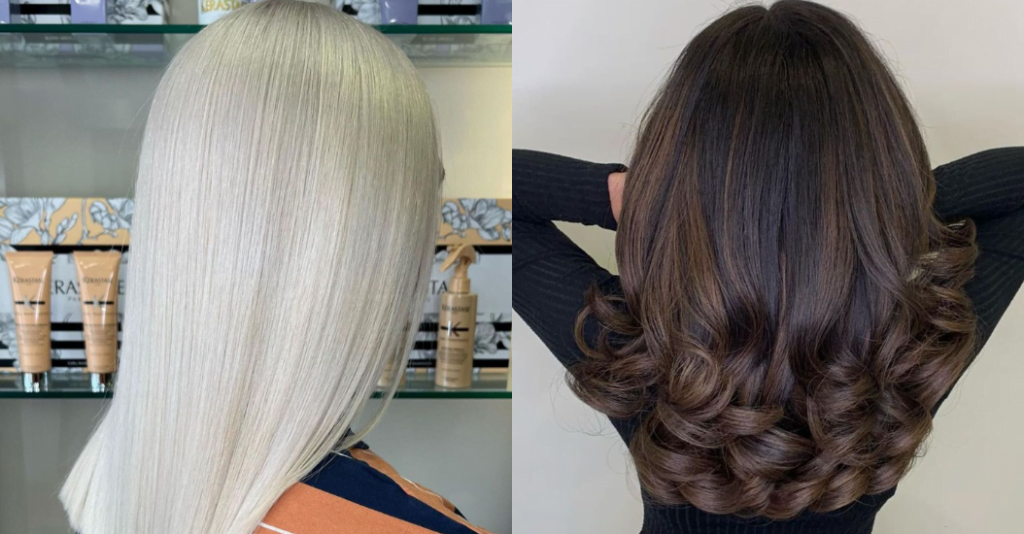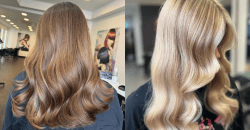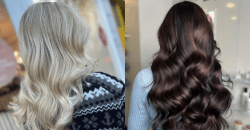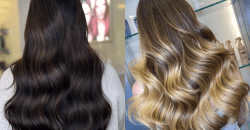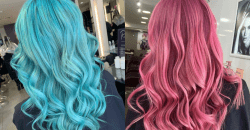What hair colour suits me and my skin tone? Discovering the perfect hair colour isn’t just about the latest trends; it’s about matching your natural complexion to leave your locks looking fresh and your skin glowing.
How you colour your hair speaks volumes about your style, making it crucial to choose shades that complement your natural appearance and individual tastes. In this guide, we delve into the differences between skin tone and undertone and offer expert advice on selecting the best hair colour for you.
Skin Tone vs. Undertone: Explaining the Differences
While most can identify their skin as fair, medium, or dark, the concept of undertones – warm, cool, or neutral – is what truly defines the palette that compliments you best.
Undertone is the subtle hue beneath your skin’s surface. Unlike your skin tone, which can vary, your undertone remains constant, making it a vital consideration for choosing your ideal hair colour, as well as makeup and jewellery.
How to Find Your Skin Tone
Look at Your Veins
Check the colour of your veins under natural light. Blue or purple veins suggest cool undertones, greenish veins indicate warm undertones and veins that blend in with your skin suggest a neutral undertone.
Sun Reaction
Consider how your skin reacts to the sun. Burning easily suggests cool undertones, while tanning easily suggests warm or neutral undertones.
Eye and Hair Colour
Cool undertones often accompany blue, green, or grey eyes with blonde, brown, or black hair. Warm undertones are usually paired with brown, amber, or hazel eyes and hair with red, gold, or auburn tints.
Colour Palette
Your preferred clothing colours can also hint at your undertone. Cool undertones lean towards blues and purples, while warm undertones prefer earthy tones like reds and oranges.
Jewellery Test
Silver and platinum flatter cool undertones, whereas gold highlights warm undertones. A mix of both suggests a neutral undertone.
What Hair Colour Suits Me?
Your skin tone and undertone play a significant role in finding the hair colour that enhances your natural beauty. Here, we break down the best hair colours based on your skin’s characteristics.
Finding The Right Hair Colour for Your Skin Tone and Undertone
| Skin Tone and Undertone | Recommended Hair Colour | Colours to Avoid |
| Light Skin with Cool Undertones | Cool, icy platinum blonde or ashy hues. Experiment with cool shades of purple and red for darker options. | Yellow or brassy hues, which can make the skin appear washed out. |
| Light Skin with Warm Undertones | Warm golden blondes, rich honey tones, or soft copper shades to enhance the skin’s natural warmth. | Overly ashy tones that might clash with the skin’s natural warmth. |
| Medium Skin with Cool Undertones | Beige blondes, sandy browns, or cool, mocha brunettes to neutralise redness and provide elegance. | Deep, stark colours that can overshadow the coolness of the skin. |
| Medium Skin with Warm Undertones | Caramel browns, warm chestnut, or sun-kissed highlights to accentuate the golden undertones. | Ashy shades that can mute the skin’s natural warmth. |
| Dark Skin with Cool Undertones | Rich espresso or luxurious blue-black to beautifully contrast with the skin while highlighting its coolness. | Vibrant reds and oranges which might not complement the undertone. |
| Dark Skin with Warm Undertones | Warm chocolate browns, deep coppers, or even burgundy to enrich the skin’s warmth. | Cooler, pale shades that might lead to a muted appearance. |
| Olive Skin | Dark ash browns, mocha shades, or warm golds for a lighter touch that complements the unique greenish undertones. | Bright, platinum blondes or very light shades that contrast sharply with the skin. |
Hair Colours for Cool Skin Tone
Individuals with cool skin undertones have a unique glow that is best accentuated with specific hair colours. These tones often reflect blue, pink, or red hues under the skin’s surface, making certain hair colours particularly flattering.
Best Choices: Ash blondes and icy platinums are ideal for highlighting the porcelain-like clarity of cool skin tones, offering a striking contrast that brings out the skin’s natural luminosity. Deep, blue-based brunettes add a rich depth, enhancing the cool undertones without overwhelming them.
Examples: Think of the frosty elegance of a silver-ash blonde or the sophisticated depth of a sapphire black. These shades work harmoniously with your skin’s cool base to create a cohesive and stunning look.
Unsure of your hair type? Read our Hair Types Explained blog.
Hair Colours for Warm Skin Tone
Warm skin tones glow with underlying hints of peach, yellow, or gold. Choosing hair colours that complement this warmth can enhance your skin’s natural vibrancy and give you a sun-kissed look regardless of the season.
Best Choices: Honey blondes, rich auburns, and golden browns are perfect for adding a radiant warmth to your complexion. These shades mimic the golden hues of sunlight, enhancing the natural warmth of your skin tone.
Examples: Imagine the golden hues of a caramel blonde or the rich, earthy tones of a chestnut brown. These colours are designed to complement and amplify the warm undertones of your skin, creating a naturally radiant appearance.
Hair Colours for Neutral Skin Tone
If you’re lucky enough to have a neutral skin tone, you’ll find that a wide spectrum of hair colours naturally suits you. This versatility comes from having a balanced mix of cool and warm undertones, allowing for greater freedom in colour experimentation.
Best Choices: From light, sun-kissed blondes to deep, sultry browns, those with neutral undertones can daringly experiment with a broad palette. This freedom means you can choose hair colours based on personal preference rather than compatibility.
Examples: Consider the softness of a sandy blonde or the depth of a walnut brown. Neutral skin tones can effortlessly swing between hair colours, finding beauty in both cool and warm shades.
Hair Colours for Olive Skin Tone
Olive complexions are beautifully unique, characterised by their natural, earthy undertones that blend greenish and neutral hues. Selecting the right hair colour can illuminate this natural radiance, enhancing the skin’s golden or greenish undertones.
Best Choices: Ash browns and warm golds are particularly flattering, as they complement the skin’s natural depth without overpowering it. These shades can add dimension and warmth to olive skin, highlighting its natural glow.
Examples: Envision the muted elegance of an ash brown or the subtle richness of a golden bronze. These hair colours enhance the natural beauty of olive skin, adding warmth and depth to create a harmonious and attractive look.
Non-natural Hair Colours
Dare to be different with unicorn or pastel shades. Your skin tone and undertone still play a role in which non-traditional colours suit you best. Fair, cool complexions shine with pastel pinks, while warm undertones are illuminated by pastel blues and peaches. Vibrant jewel tones like fuchsia or magenta bring out the depth in medium to dark skin tones, especially those with cool undertones.
Caring for Your Perfect Hair Colour
To maintain your vibrant hair colour:
- Use colour-protecting shampoo and conditioner.
- Avoid excessive heat styling.
- Regularly hydrate and nourish your hair with masks or oils.
Correcting a hair colour gone wrong can be daunting. Learn how to get your desired shade back with our Hair Colour Correction blog.
Ready to embrace the perfect hair colour that truly reflects your individuality? Find a hairdresser near you and book your appointment today. Let our experts help you achieve a look that not only turns heads but also perfectly complements your natural beauty.
By understanding the nuances of your skin tone and undertone, you can select a hair colour that suits your natural complexion and reflects your style. Whether you’re considering a subtle change or a bold new look, the right hair colour can enhance your features and boost your confidence.
FAQs
Q: How Do I Know If I Have Cool Undertones?
A: Look for blue or purple veins and a preference for silver jewellery.
Q: How Do I Know If My Hair Colour Is Warm Or Cool?
A: Warm colours have a golden, yellow, or red base, while cool colours lean towards blue, green, or violet undertones.
Q: Do Warm Hair Colours Look Good On Cool Skin?
Yes, but choosing the right shade to complement your undertone is key.
Q: What Colours Should Cool Skin Tones Avoid?
A: Avoid overly warm shades that can clash with your skin’s cool undertones.
Q: Can I switch from warm to cool hair colours if I’m bored with my current shade?
A: Yes, you can switch between warm and cool hair colours, but it’s important to consider how the new shade will work with your undertone. A colour consultation with a professional can help you choose a shade that transitions well with your natural tones.
Q: What’s the best way to transition to a completely different hair colour?
A: Gradually transitioning through softer shades or highlights can help manage the change without causing too much shock to your appearance or damage to your hair. Consulting with a colourist is crucial for planning a major colour change.
Q: How do I find the right hair colour for my skin tone?
A: Assess your skin’s undertone and choose colours that complement it: ash and icy tones for cool undertones, warm golds and caramels for warm undertones.
Q: How do I choose my hair colour from my skin?
A: Match hair colour with your skin’s undertone—cool undertones suit ash and icy colours, warm undertones look best with golden and warm shades.
Q: Am I cool or warm-toned?
A: Look at your wrist veins: blue or purple indicates cool, and green suggests warm. Consider how your skin reacts to the sun and which jewellery colours suit you.
Q: What hair colour for cool skin and blue eyes?
A: Choose ashy blondes or cool brunettes to complement cool skin and enhance blue eyes. Avoid warm tones.

